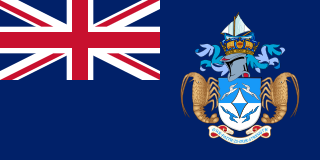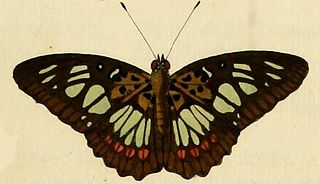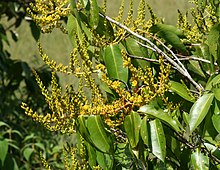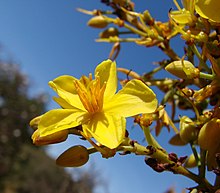
Tristan da Cunha, colloquially Tristan, is a remote group of volcanic islands in the South Atlantic Ocean. It is the most remote inhabited archipelago in the world, lying approximately 2,787 kilometres (1,732 mi) from Cape Town in South Africa, 2,437 kilometres (1,514 mi) from Saint Helena, 3,949 kilometres (2,454 mi) from Mar del Plata in Argentina, South America and 4,002 kilometres (2,487 mi) from the Falkland Islands.

The tropics are the regions of Earth surrounding the Equator. They are defined in latitude by the Tropic of Cancer in the Northern Hemisphere at 23°26′10.2″ (or 23.43616°) N and the Tropic of Capricorn in the Southern Hemisphere at 23°26′10.2″ (or 23.43616°) S. The tropics are also referred to as the tropical zone and the torrid zone.
Cypress is a common name for various coniferous trees or shrubs of northern temperate regions that belong to the family Cupressaceae. The word cypress is derived from Old French cipres, which was imported from Latin cypressus, the latinisation of the Greek κυπάρισσος (kyparissos). Cypress trees are a large classification of conifers, encompassing the trees and shrubs from the cypress family (Cupressaceae) and many others with the word cypress in their common name. Many cypress trees have needle-like, evergreen foliage and acorn-like seed cones.

Fairchild Tropical Botanic Garden is an 83-acre (34 ha) botanic garden with extensive collections of rare tropical plants including palms, cycads, flowering trees, and vines. It is located in the city of Coral Gables, Miami-Dade County, just south of Miami, surrounded at the north and west by Matheson Hammock Park.

Ochnaceae is a family of flowering plants in the order Malpighiales. In the APG III system of classification of flowering plants, Ochnaceae is defined broadly, to include about 550 species, and encompasses what some taxonomists have treated as the separate families Medusagynaceae and Quiinaceae. In a phylogenetic study that was published in 2014, Ochnaceae was recognized in the broad sense, but two works published after APG III have accepted the small families Medusagynaceae and Quiinaceae. These have not been accepted by APG IV (2016).

Lycopus is a genus of herbaceous plants in the family Lamiaceae. The many species are known as water horehound, gypsywort, and bugleweed and are native to Europe, Asia, Australia, and North America. The species are most often found in wetlands, damp meadows, and stream banks. Some of the wetland species have become endangered.
Saint Helena, Ascension Island and Tristan da Cunha, as well the other uninhabited islands nearby, are a haven for wildlife in the middle of the Atlantic Ocean. The islands are or were home to much endemic flora and fauna, especially invertebrates, and many endemic fish species are found in the reef ecosystems off the islands. The islands have been identified by BirdLife International as Important Bird Areas for both their endemic landbirds and breeding seabirds.

Bidens amplectens, the Waiʻanae kokoʻolau, is a species of flowering plant in the family Asteraceae. It belongs to the genus Bidens, collectively called kokoʻolau or koʻokoʻolau in the Hawaiian language. It is found in coastal and dry lowland habitats in the Waiʻanae Range on Oʻahu. It is threatened by habitat loss due to the spread of invasive weeds and brush fires. The species is also threatened by climate change and habitat degradation, and herbivory. Bidens amplectens is currently listed as endangered under the Endangered Species Act.

Campylospermum is a genus of flowering plants in the family Ochnaceae. It includes 55 species native to tropical Africa, India, Indochina, Hainan, and western Malesia.

Campylospermum serratum is a plant in the family Ochnaceae. The specific epithet serratum is from the Latin meaning "with teeth", referring to the leaf margin. It is found in Tropical Asia, from Sulawesi, Indonesia to Hainan, Zhōngguó/China and over to southwester India. Gomphia serrata was a previous common name for the species. The plant is used for it wood and its sap is used in folk medicine and in the past for teeth-blackening.
Campylospermum amplectens, synonym Ouratea amplectens, is a species of plant in the family Ochnaceae. It is found in west tropical Africa: Ghana, Ivory Coast, Liberia and Sierra Leone. It is threatened by habitat loss.
Ouratea glomerata(Pohl) Sastre & Offroy is a species of flowering plant in the family Ochnaceae, native to west-central Brazil. It was first described by Johann Baptist Emanuel Pohl in 1833 as Gomphia glomerata.

The Paleotropical Kingdom (Paleotropis) is a floristic kingdom composed of the tropical areas of Africa, Asia and Oceania, as proposed by Ronald Good and Armen Takhtajan. Part of its flora is inherited from the ancient supercontinent of Gondwana or exchanged later. These Gondwanan lineages are related to those in the Neotropical Kingdom, composed of the tropical areas of Central and South America. Flora from the Paleotropical Kingdom influenced the tropical flora of the Australian Kingdom. The kingdom is subdivided into five floristic subkingdoms according to Takhtajan and about 13 floristic regions. In this article the floristic subkingdoms and regions are given as delineated by Takhtajan.

Allium amplectens, the narrowleaf onion, is a species of flowering plant. It is a onion native to the west coast of the United States, in Oregon, Washington State and California, also British Columbia in Canada. It grows in woods and especially in clay and serpentine soils.

Ascension Island is an isolated volcanic island, 7°56′ south of the Equator in the South Atlantic Ocean. It is about 1,000 miles (1,600 km) from the coast of Africa and 1,400 miles (2,300 km) from the coast of South America. It is governed as part of the British Overseas Territory of Saint Helena, Ascension and Tristan da Cunha, of which the main island, Saint Helena, is around 800 miles (1,300 km) to the southeast. The territory also includes the sparsely populated Tristan da Cunha archipelago, 2,300 miles (3,700 km) to the south, about halfway to the Antarctic Circle.

The Ascension scrub and grasslands ecoregion covers the dormant volcano, Ascension Island in the Atlantic Ocean. As well as shrubs and grasses wildlife on the island includes a range of unique flora and fauna. In particular the surrounding islets are important havens for many seabirds. However the seabird populations on Ascension Island itself have been severely affected by introduced species, especially cats, which were the subject of an eradication campaign between 2002 and 2006.

Tristan da Cunha is an archipelago of five islands in the southern Atlantic Ocean, the largest of which is the island of Tristan da Cunha itself and the second-largest, the remote bird haven, Gough Island. It forms part of a wider territory called Saint Helena, Ascension and Tristan da Cunha which includes Saint Helena and Ascension Island.

Trifolium depauperatum is a species of clover known by the common names cowbag clover, poverty clover, and balloon sack clover.

Pseudacraea semire, the green false acraea, is a butterfly in the family Nymphalidae. It is found in Guinea, Sierra Leone, Liberia, Ivory Coast, Ghana, Togo, Nigeria, Cameroon, Gabon, the Republic of the Congo, the Central African Republic, Angola, the Democratic Republic of the Congo, western Uganda, north-western Tanzania and north-western Zambia.

Lycopus amplectens, common names clasping-leaved water-horehound, sessile-leaved bugleweed, and sessile-leaved water-horehound, is a species of Lycopus native to North America.

















